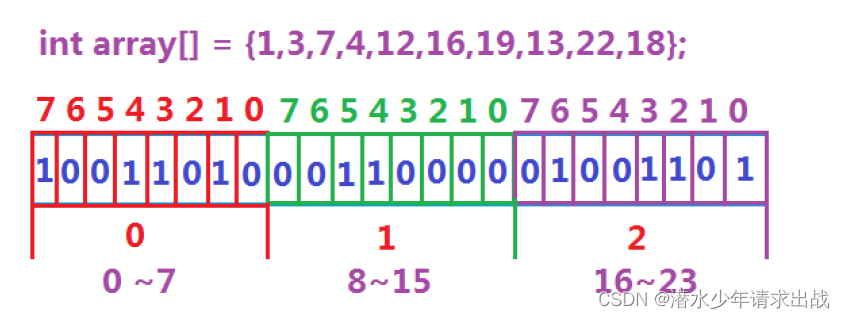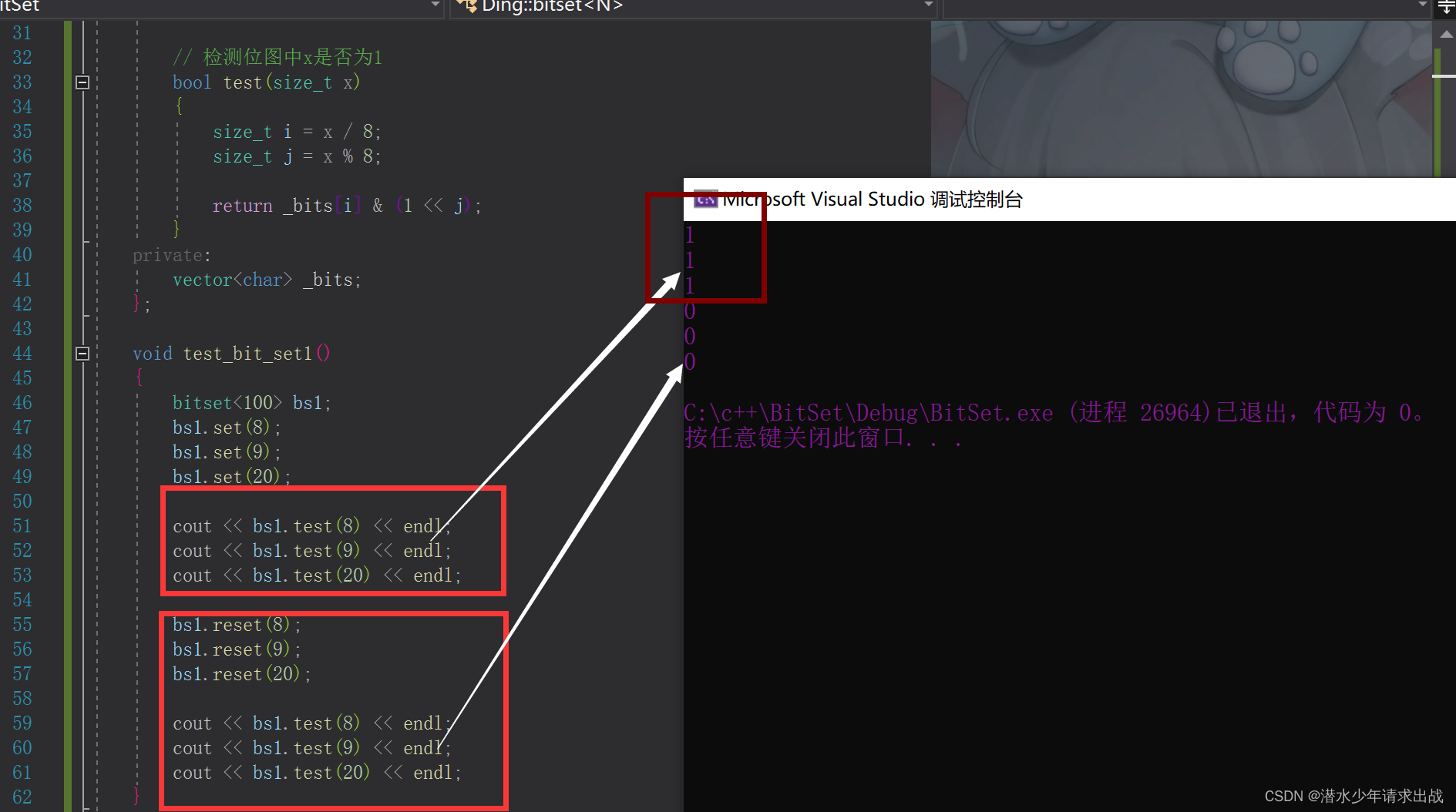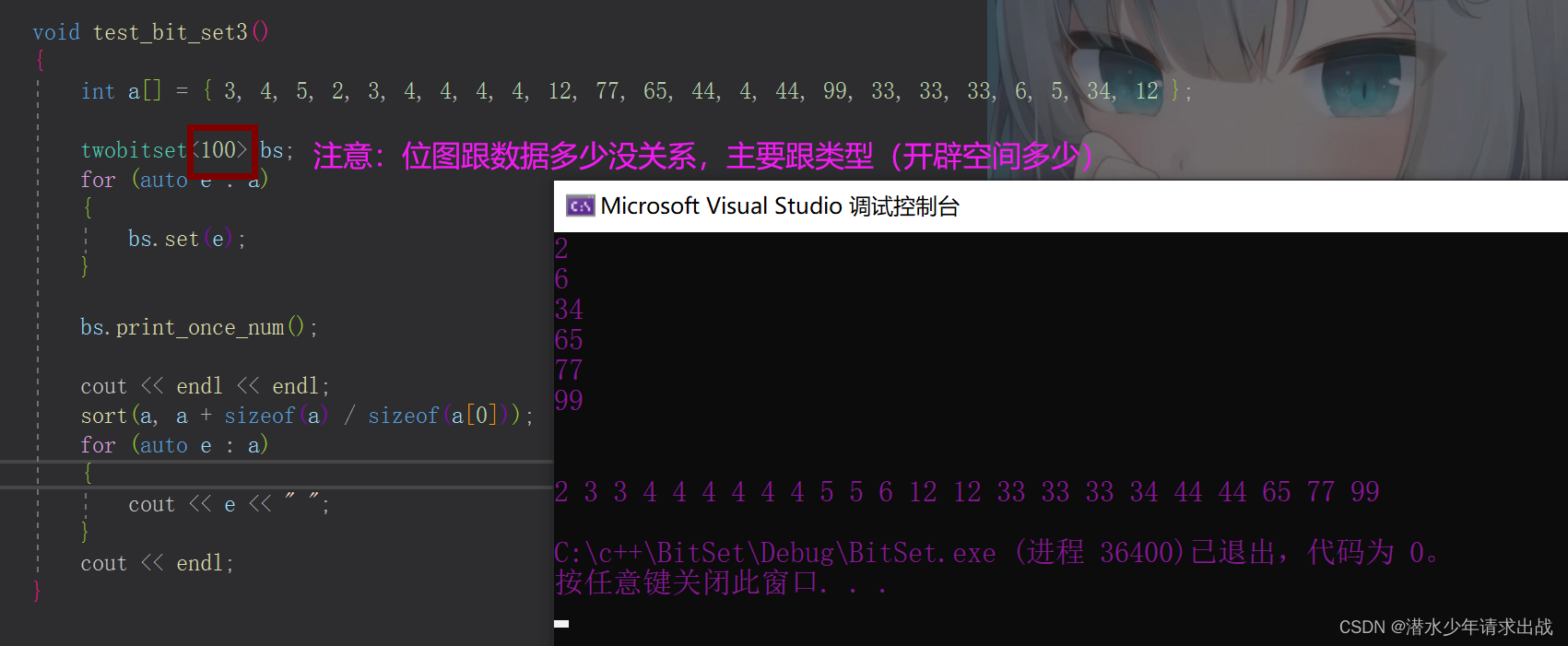_cpp 位图
创始人
2024-01-20 23:19:45
0次
文章目录
- 1. 位图概念
- 1.1 给40亿个不重复的无符号整数,没排过序。给一个无符号整数,如何快速判断一个数是否在这40亿个数中。
- 2. 位图的实现
- 2.1 运行结果:
- 3. 位图应用
- 3.1 具体代码封装实现如下
- 3.2 部分结果演示:
- 3.3 应用总结:
- 4. 位图特点
1. 位图概念
- 所谓位图,就是用每一位来存放某种状态,适用于海量数据,数据无重复的场景。通常是用来判断某个数据存不存在的。
1.1 给40亿个不重复的无符号整数,没排过序。给一个无符号整数,如何快速判断一个数是否在这40亿个数中。
- 注意:数据很大
- 搜素树和哈希表都不太行(内存存不下)
- 排序+二分查找(数据太大只能放在磁盘中,效率太低以及不好支持二叉查找)
- 位图–直接定址法(一个bit位映射标记值,1在;0不在)空间开512MB(半G)
- 遍历,时间复杂度O(N)
- 排序(O(NlogN)),利用二分查找: logN
- 位图解决:
数据是否在给定的整形数据中,结果是在或者不在,刚好是两种状态,那么可以使用一个二进制比特位来代表数据是否存在的信息,如果二进制比特位为1,代表存在,为0
代表不存在。比如:

利用char通过除和模实现。
例子:如下图

2. 位图的实现
namespace Ding
{templateclass bitset{public:bitset(){_bits.resize(N / 8 + 1, 0);}// 将x比特位置1void set(size_t x){size_t i = x / 8;size_t j = x % 8;_bits[i] |= (1 << j);}// 将x比特位0void reset(size_t x){size_t i = x / 8;size_t j = x % 8;_bits[i] &= ~(1 << j);}// 检测位图中x是否为1bool test(size_t x){size_t i = x / 8;size_t j = x % 8;return _bits[i] & (1 << j);}private:vector _bits;};void test_bit_set1(){bitset<100> bs1;bs1.set(8);bs1.set(9);bs1.set(20);cout << bs1.test(8) << endl;cout << bs1.test(9) << endl;cout << bs1.test(20) << endl;bs1.reset(8);bs1.reset(9);bs1.reset(20);cout << bs1.test(8) << endl;cout << bs1.test(9) << endl;cout << bs1.test(20) << endl;}
}
2.1 运行结果:

3. 位图应用
-
- 给定100亿个整数,设计算法找到只出现一次的整数?
-
- 给两个文件,分别有100亿个整数,我们只有1G内存,如何找到两个文件交集?
-
- 位图应用变形:1个文件有100亿个int,1G内存,设计算法找到出现次数不超过2次的所有整数。
一个位图一般标记一个数在和不在;数据太大状态多;我们可以用两个位图来标记。
例如:00:未出现;01:表示出现一次;10:表示出现二次;11:表示出现3次及以上。两个位图分别取其中一个bit位来表示即可。
- 题目一:

- 题目二:

- 题目三:

3.1 具体代码封装实现如下
namespace Ding
{templateclass twobitset{public:void set(size_t x){bool inset1 = _bs1.test(x);bool inset2 = _bs2.test(x);if (inset1 == false && inset2 == false){//->01_bs2.set(x);}else if (inset1 == false && inset2 == true){//->10_bs1.set(x);_bs2.reset(x);}else if (inset1 == true && inset2 == false){//->11_bs2.set(x);}}void print_once_num(){for (size_t i = 0; i < N; ++i){if (_bs1.test(i) == false && _bs2.test(i) == true) //01{cout << i << endl;}}}private:bitset _bs1;bitset _bs2;};void test_bit_set3(){int a[] = { 3, 4, 5, 2, 3, 4, 4, 4, 4, 12, 77, 65, 44, 4, 44, 99, 33, 33, 33, 6, 5, 34, 12 };twobitset<100> bs;for (auto e : a){bs.set(e);}bs.print_once_num();cout << endl << endl;sort(a, a + sizeof(a) / sizeof(a[0]));for (auto e : a){cout << e << " ";}cout << endl;}
}
3.2 部分结果演示:

3.3 应用总结:
- 快速查找某个数据是否在一个集合中
- 排序 + 去重
- 求两个集合的交集、并集等
- 操作系统中磁盘块标记
4. 位图特点
- 快,节省空间—直接定址法、不存在冲突
- 相对局限只能处理整形。
相关内容
热门资讯
喜欢穿一身黑的男生性格(喜欢穿...
今天百科达人给各位分享喜欢穿一身黑的男生性格的知识,其中也会对喜欢穿一身黑衣服的男人人好相处吗进行解...
网络用语zl是什么意思(zl是...
今天给各位分享网络用语zl是什么意思的知识,其中也会对zl是啥意思是什么网络用语进行解释,如果能碰巧...
发春是什么意思(思春和发春是什...
本篇文章极速百科给大家谈谈发春是什么意思,以及思春和发春是什么意思对应的知识点,希望对各位有所帮助,...
为什么酷狗音乐自己唱的歌不能下...
本篇文章极速百科小编给大家谈谈为什么酷狗音乐自己唱的歌不能下载到本地?,以及为什么酷狗下载的歌曲不是...
苏州离哪个飞机场近(苏州离哪个...
本篇文章极速百科小编给大家谈谈苏州离哪个飞机场近,以及苏州离哪个飞机场近点对应的知识点,希望对各位有...
家里可以做假山养金鱼吗(假山能...
今天百科达人给各位分享家里可以做假山养金鱼吗的知识,其中也会对假山能放鱼缸里吗进行解释,如果能碰巧解...
华为下载未安装的文件去哪找(华...
今天百科达人给各位分享华为下载未安装的文件去哪找的知识,其中也会对华为下载未安装的文件去哪找到进行解...
四分五裂是什么生肖什么动物(四...
本篇文章极速百科小编给大家谈谈四分五裂是什么生肖什么动物,以及四分五裂打一生肖是什么对应的知识点,希...
怎么往应用助手里添加应用(应用...
今天百科达人给各位分享怎么往应用助手里添加应用的知识,其中也会对应用助手怎么添加微信进行解释,如果能...
客厅放八骏马摆件可以吗(家里摆...
今天给各位分享客厅放八骏马摆件可以吗的知识,其中也会对家里摆八骏马摆件好吗进行解释,如果能碰巧解决你...